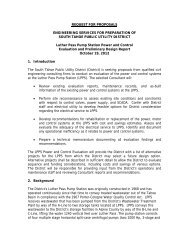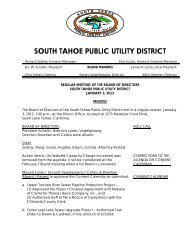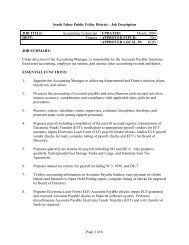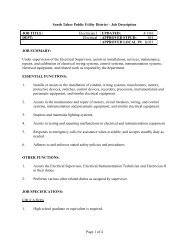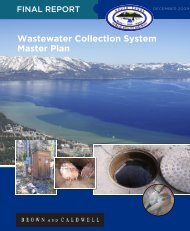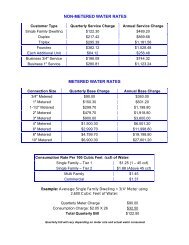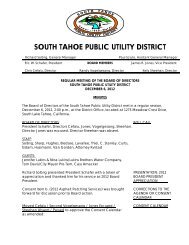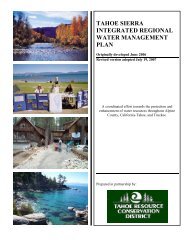October 2009 - South Tahoe Public Utility District
October 2009 - South Tahoe Public Utility District
October 2009 - South Tahoe Public Utility District
Create successful ePaper yourself
Turn your PDF publications into a flip-book with our unique Google optimized e-Paper software.
those land owners that have traditionally benefited from a mixed recycled water tailwater inflow<br />
from California.<br />
This agreement was entered in June of 2003 and is administered and enforced by NDEP.<br />
6.4 Anticipated Permitting Requirements<br />
The following discussion provides an overview of some of the potential environmental permitting<br />
issues that apply to projects of the Master Plan. Additional issues may be identified as each<br />
option is further evaluated.<br />
6.4.1 NEPA Documentation<br />
The projects of the Master Plan may be at least partially located on lands under the jurisdiction<br />
of the Bureau of Land Management and the U.S. Forest Service. The National Environmental<br />
Policy Act (NEPA) requires federal agencies to conduct environmental review before<br />
undertaking any federal action that could affect the environment, including the use of federally<br />
managed lands.<br />
Use of this property requires approval of federal agencies. Environmental requirements under<br />
NEPA may be met by completion of an Environmental Assessment or Environmental Impact<br />
Statement. Any project implemented is subject to NEPA requirements and evaluated with<br />
environmental documentation.<br />
6.4.2 The California Environmental Quality Act (CEQA)<br />
The proposed Master Plan projects are subject to the requirements of The California<br />
Environmental Quality Act (CEQA). CEQA defines a “project” as an activity where the whole of<br />
an action, which has the potential for resulting in either a direct physical change in the<br />
environment, or a reasonably foreseeable indirect change in the environment.<br />
Title 14, Article 18, Statutory Exemptions, Section 15262, of CEQA states that “a project<br />
involving the feasibility of planning studies for possible future actions which the agency, board,<br />
or commission has not approved, adopted, or funded does not require the preparation of an EIR<br />
or Negative Declaration but does require consideration of environmental factors. This section<br />
does not apply to the adoption of a plan that will have a legally binding effect on later activities.”<br />
Once a strategy and/or alternative has been recommended, the strategy and/or alternative is<br />
subject to review to determine if the activity is ministerial, has no possible significant effect, is<br />
statutory exempt, or is eligible for a categorical exemption. If the activity is not exempt, then the<br />
activity is reviewed for any significant effects on the environment. If there are no significant<br />
effects on the environment, the activity may be eligible for a Negative Declaration. If significant<br />
effects are found, the activity is subject to an EIR under the CEQA regulations.<br />
6.4.3 Endangered Species Act<br />
The U.S. Fish and Wildlife Service (FWS) administers the Endangered Species Act (ESA).<br />
Plants and animals listed as threatened or endangered are protected, as is their habitat. The<br />
FWS must be contacted regarding potential impacts to habitat and protected species pursuant<br />
to Section 7 of the Endangered Species Act. A permit may be required if it is determined that<br />
the project could impact a protected species or it‟s habitat.<br />
<strong>South</strong> <strong>Tahoe</strong> <strong>Public</strong> <strong>Utility</strong> <strong>District</strong><br />
Recycled Water Facilities Master Plan - <strong>October</strong> <strong>2009</strong> Page 6-46



